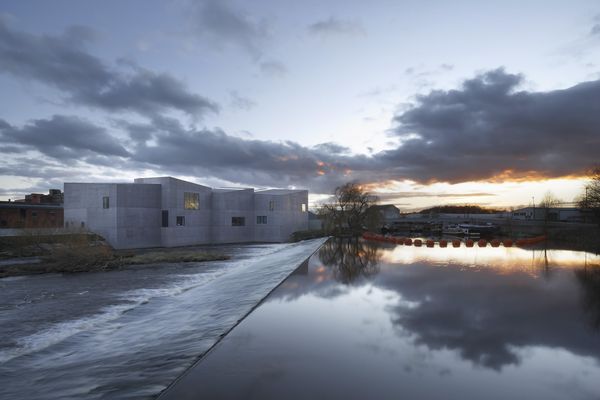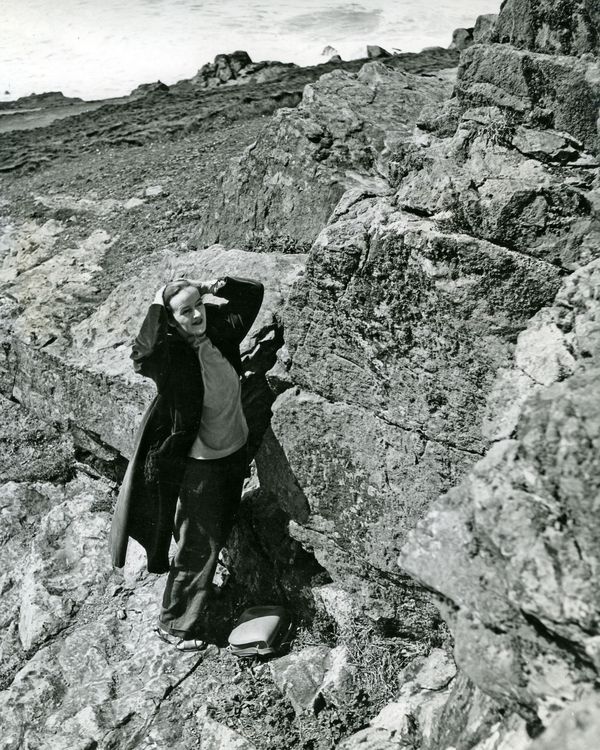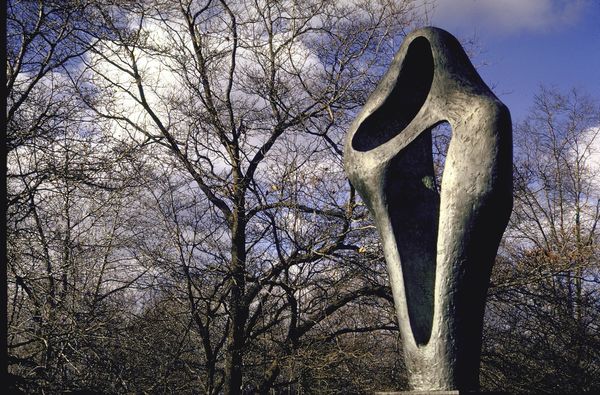Hepworth at her studio in St Ives, Cornwall, in 1958 © Pictorial Press Ltd / Alamy
No one could seriously claim that Barbara Hepworth is not a major sculptor with a significant international reputation. The Museum of Modern Art in New York was an early adopter, after all, acquiring their first work by the British artist in 1934. By the 1960s her sensuously epic Single Form (1964) was gracing the Plaza of the United Nations Building. Five years ago, 36 years after her death, David Chipperfield designed a world-class museum building in her honour in her hometown of Wakefield. And yet…and yet…she remains underrated and less appreciated than she ought to be.


(Top) Hepworth sits with United Nations Secretary General U. Thant (left) and former U.S. delegate Jacob Blaustein (right) after the unveiling of her statue in front of the UN Secretariat Building in New York on June 11th, 1964. The statue was dedicated to the late Dag Hammarskjold. © Credit:Topham / AP; (Bottom) The Hepworth Wakefield, Margate, United Kingdom. Architect: David Chipperfield Architects Ltd, 2011. © The Hepworth Wakefield
Over the decades, Hepworth's capacity to assimilate and work alongside other artists – one of her great strengths – has been used against her. She learned traditional marble-carving techniques in Rome in the mid-1920s with her first husband, John Skeaping. She travelled extensively with Ben Nicholson the following decade and spent time in the studios of Picasso, Braque, Brancusi, Arp and Mondrian, and joined the Abstraction-Création group in 1934. Living in St Ives with Nicholson after the outbreak of the Second World War, she became part of a small but extraordinarily potent artistic colony together with Naum Gabo. And then, of course, there's Henry Moore, from whose shadow she has only posthumously emerged.
I, the sculptor, am the landscape.
— Barbara Hepworth


(Top) Hepworth on the cliffs near her studio in St Ives, Cornwall, in 1958 © Pictorial Press Ltd / Alamy; (Bottom) Hepworth sketching near her home, St Ives, Cornwall © BBC Photo Library 2016
Like most great artists, Hepworth learned from others but equally she formed her own sculptural language, striking a different note in the male-dominated world of Modernist abstraction. It clearly came from her profound affinities with physical matter, particularly stone and wood, later with plaster and bronze – what she described as her "poetic demands from the material." But it went deeper. As a child, she recalled frequently driving around the West Riding of Yorkshire with her father, a civil engineer. "All my early memories are of forms and shapes and textures," she later revealed, "the hills were sculptures. Above all, there was the sensation of moving physically over the contours of fullnesses and concavities, through hollows and over peaks – feeling, touching, seeing, through mind and hand and eye. The sensation has never left me. I, the sculptor, am the landscape."
The notion of being at one with nature has become a post-Romantic cliché, but not in Hepworth's case. Wherever her work is seen – in galleries, houses, sculpture gardens, parks or public piazzas – the sense of immersion in a landscape is there. Sometimes it's the underlying rhythms of the natural world that are suggested; at other times there are tensions felt by Hepworth in response to a place "between myself and the sea, the wind or the hills." She is an artist of light and air, of growth and form, of surface and depth, of movement and monument.


(Top) Epidaurus by Barbara Hepworth, St Ives, U.K. © Universal Images Group North America LLC / DeAgostini / Alamy Stock Photo; (Bottom) Barbara Hepworth; Joseph H. Hirshhorn [Misc.] © Gjon Mili/Getty Images
Her reworking of the idea of sculpture as a public monument was remarkable, particularly in her late work. Forms were simplified, distilled through modernist abstraction; but she also managed to reconnect with prehistoric traditions in works that evoked a primordial energy, often stemming from her engagement with "the pagan landscape" of West Cornwall. The physical scale of her work varied but its impact, to me, always feels both epic and human. Perhaps this paradox is where the power of her art lies. It has a fluidity that evokes questions about who we are and where we stand in the grand scheme of things. She put it more thoughtfully and eloquently: "I think the very nature of art is affirmative, and in doing so reflects the laws, and the evolution of the universe – both in the power and rhythm of growth and structure as well as the infinitude of ideas which reveal themselves when one is in accord with the cosmos and the personality is free to develop."
Late Hepworth, an exhibition in celebration of The Hepworth Wakefield's fifth anniversary, runs from 6 July through 27 August at Phillips London.
Tim Marlow is artistic director of the Royal Academy of Arts, London.
